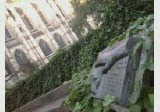Okay, so I actually did NOT go into any hotel. But I walked by a hotel recently. It's not quite the joke you imagine. Just over a week ago, I attended a meeting-tour of the New York Theological Libraries Association (NYATLA), which met at the Pierpont Morgan Library in midtown Manhattan. On the way to the meeting, I happened to walk by the locally famous "Library Hotel," which I'll surely have to explore more in depth at another time, because it is clearly an interesting and curious operation, which bases its floors, rooms, and suites on the Dewey Decimal System. Of course, to many in academic libraries, Dewey is an outdated system, often supplanted by LC classification. To Dewey's credit, he did do a stint as University Librarian at Columbia back in the 1880s. So we'll keep him for now! The Library Hotel is located off of Madison Avenue and East 41st Street, not far from either the Pierpont Morgan Library or the New York Public Library.

The Pierpont Morgan Library, where we met and had our tour was a magnificent place, and indeed, a magnificent institution with an abundance of cultural treasures. Located around E. 37th and Madison Avenue, the library has recently been expanded and updated with a marvelous new social gathering space designed by famed architect Renzo Piano. The New York Times had a review of it back in 2006. It is really quite a remarkable space, full of light and glass and modern angles that make you feel like you're in a fantastically naturalistic outdoor cathedral. This space connects various parts of the museum and library, including the gift and book shop, the dining room, the cafe, the galleries (both up- and downstairs), as well as what I'd consider the focal attractions of J.P. Morgan's study and library. In these rooms, Morgan's study specifically, one can cast a glance at where the seat of American financial decision making and power took place more than a century ago--including the massive vault adjacent to Mr. Morgan's study. Oddly, the vault on the day of the visit was open, and visitors could see hundreds of rare books on the interior shelves, while a table stood in the middle of the vault with a charming couplet portraiture of Martin Luther and his wife Katharina Luther (nee von Bora)! I was assured that this was not Morgan's idea! In the private library nearby, separated from the study by a rotunda-style middle-room with pillars, there were displays of manuscripts of the great classic composers, including Mozart's manuscript of his Symphony No. 35, some Schumann chamber works, and a Cantata of Bach! It was astounding to see such handwriting of the greats, and hard to fathom that they'd touched the very pages that lay within inches of my nose, as I focused entranced on each object! They also had proofs of famous books and scribbles from their authors (Lewis Carol, for example), as well as an early Caxton edition of Chaucer's Canterbury Tales, dating from the 1400s. They also had a great exhibit on the history of diaries. So if you have time to see it before it ends, I recommend it.
I made my way back afterward, past the New York Public Library and snapped this photo of the famous lions (or at least one of those lions!) Inside, there is a wonderful exhibit of "The Three Faiths," which includes dozens of rare books from Judaism, Christianity, and Islam. The place was packed with visitors when I went in, so I didn't stay that long. But what I saw was remarkable. I think that another visit and photographic essay should be devoted to this whole library, because it is simply extraordinary. As one of the largest libraries in the world, the NYPL has much to offer. And it's a gorgeous architectural gem, right in the middle of the city. I think if I had more time, I would have stayed longer...and not just because it was warmer inside than the freezing temperatures outside! There is a bigger story to tell here about this library, but we'll wait till it warms up.





























